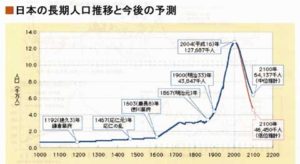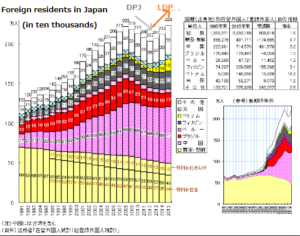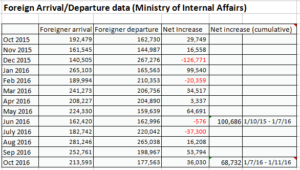
I am Japanese national, living in Toyocho, Koto ward in Tokyo’s inner eastern suburb, with my wife who is Australian Chinese, plus two kids who have both Japanese and Australian passports. The Toyocho area is popular residential area typically for growing families like ours. Non-Japanese residents from China, Vietnam, Philippines, India etc.. are not uncommon in our community.
Based on our experience and several government statistics, I would like to share my views on Japan’s recent population trends.
The below is a popular graph of Japan’s long-term population trend (AD 1000 – 2100) prepared by IPSS (National Institute of Population and Social Security Research) in early 2013. This graph often becomes a ground of Japan’s woes on its declining, ageing population. Some articles say Japan is diminishing even. Indeed, the graph looks scary, especially for property investors like myself.
Having said that, this prediction turned out to be incorrect. Based on recent government statistics, Japan’s current population outnumbers IPSS prediction by 732,000 persons.
(As of 1/10/2016)
Actual population 126,930,000
Predicted population 126,198,000
—————————————–
Difference 732,000
I created a simple Excel graph which is much easier to understand what was happening. IPSS prediction was almost perfect until 2013, but it start deviating from 2014 and the gap widened by now. It shows the fact that Japan’s population is declining at much slower rate than originally predicted,
Why IPSS missed the population prediction? Here is the explanation.
・IPSS originally predicted natural population decrease (birth minus death) at 350 – 390K persons per year in 2015-16, but thanks to slightly improved birth rate, national decrease is around 280K per year.
・Plus net migration from overseas is counted approximately 120K per year.
・As the result, Japan’s loss of total population is around 160K per year, less than half of IPSS prediction.
Why Japan’s birth rate improved? Some people says this is the result of improved employment which made people to give birth easier. But I am not sure if this explains the story.
On the other hand, why Japan gained population via net migration from overseas? I this the reason is clear “pro-migration policy by the current government lead by LDP (Liberal Democratic Party) and prime minister Shinzo Abe”.
The below is the graph of foreign resident numbers in Japan. When DPJ (Democratic Party of Japan) rules the country between 2009 – 2012, the number kept decreasing, mainly due to the aftershock of WFC, 2011 Great Earthquake, Tsunami, Fukushima nuclear accident etc.. However, when LDP takes over in the end of 2012, the number of foreign residents came back quickly. The increase trend continues till now.
Japan controls its foreign residents by 27 types of resident status (visas). Recently we see the number of foreigners growing very fast in the below 4 visa categories. The government might have eased those visa approval criteria.
・Study visa(246,679 people, 15.0% increase in 2014/15)
・Apprentice visa(192,655 people、14.9% increase in 2014/15)
・Investment/Management visa(18,109 people、19.3% increase in 2014/15)
・Specific activity visa (37,175 people、32.8% increase in 2014/15)
Let us focus on the big picture. How foreigners’ arrival impacts Japan’s total population? Based on the data in October 2015 – July 2016, increase of foreigners offsets about half of natural decrease of the Japanese
・Japanese nationals decreased by 202K persons (125,319K -> 125,117K)
・Foreign nationals increased by 103K persons (1,775K -> 1,878K)
・Foreigner’s net migration offsets Japanese decrease by 51 percent.
The above-mentioned increase of foreign residents (103K persons) can be explained by the statistics of Ministry of Internal Affairs, based on October 2015 – July 2016, the cumulative number of foreigner’s arrival in Japan (excluding tourist visas) is greater than their departure by 101K persons, almost identical to above-mentioned 103K.
Going forward, what happened after July 2016? As of 11/1/2016, we already see foreigners’ further increase of 68,732 persons in 4 months.
After arrival in Japan, the bunch of foreigners will usually settle in areas such as Tokyo’s Shinjuku/Toshima wards, top two multi-cultural precincts in Japan. Interestingly enough, the number of local foreign residents in Shinjuku/Toshima wards exactly reflect the trend of national arrivals after 1-2 months of their entry. It should be notable information for property investors who target on foreigner’s rental demands in those areas.
After some years, foreign residents in Tokyo will start to settle in eastern suburbs such as Koto/Edogawa wards to start their family. As the results, Koto/Edogawa wards always Tokyo’s top two in terms of new birth by foreign nationals. My own family lives in Koto ward thus is counted in Japan’s statistics.
You will see the steady increase of foreign residents ratio in Koto ward, like many other areas in Tokyo.
4.34% (1/12/2012)
4.36% (1/12/2013)
4.61% (1/12/2014)
4.85% (1/12/2015)
5.17% (1/12/2016)
Conclusion
・Japan’s total population does not see as much decrease as originally predicted.
・Two factors contributes – “improved birth rate“ and “net migration from overseas”.
・The government pro-migration policy is likely contributed to the increase of foreiner’s net migration.
Unlike the countries like the US, Canada, Australia etc.. historically, Japanese society has far less exposure to foreigner’s intake. Even though its graying, decreasing population, the public allergy against foreign migration is still strong thus it is difficult to put this into political debate. Thus current government might have chosen “stealth” way of increasing net migration without many people knowing, the ease of visa approvals to Japan.
I run my own real estate business which inevitably deal with foreign buyers’ (mainly from China/Korea) desire to get resident visa in Japan. I am assisting them from the year 2010. Recently I feel it much easier to obtain approvals and I know the staffs of Tokyo Immigration Bureau have been inundated with foreigners’ visa application who want to live in Japan.
Japan’s change and challenge to be a multi-cultural society, may not as obvious as Western countries, but is certainly happening, at least obvious in Tokyo’s eastern inner suburbs, where I live.





